Our Blog & Pet Health Topics
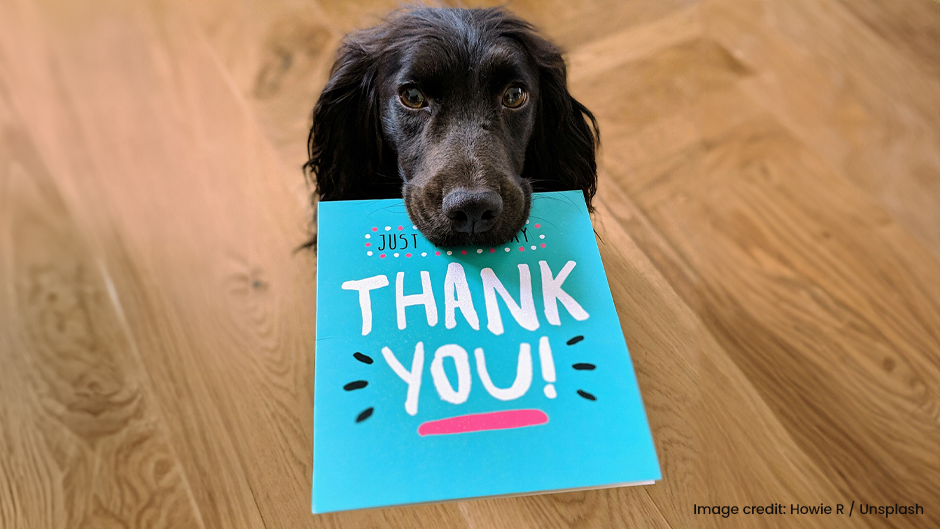
Shining a Spotlight on Our Veterinary Technicians: The Heartbeat of Our Practice
From October 13-19, 2024, we join veterinary clinics nationwide in celebrating National Veterinary Technician Week! These incredible individuals are the backbone of our clinic, working tirelessly to ensure every pet receives the care they need. If you’ve ever wondered just how our vet techs make a difference in the life of your pet, we’re here to shed some light on their remarkable work.
Here’s a closer look at how our veterinary technicians keep things running smoothly and compassionately behind the scenes:
Veterinary Technicians: Champions of Care and Compassion
Our veterinary technicians are the unsung heroes of every pet visit. From routine check-ups to unexpected emergencies, they are there, providing loving and attentive care. With their calm demeanor and specialized skills, they handle everything from comforting a nervous cat to monitoring an anxious dog during surgery.
Their day doesn’t stop at simply assisting in exams or preparing pets for surgery. Veterinary technicians dedicate their time to ensuring every animal feels secure, whether through gentle handling, careful monitoring of vital signs, or simply providing a reassuring presence during a stressful moment. Every pet, large or small, gets the VIP treatment they deserve.
Knowledge That Never Quits
You might see a veterinary technician assisting during exams, but did you know they are experts in a wide range of fields? From animal nutrition to surgical nursing, veterinary technicians undergo extensive training, mastering an impressive set of skills. They are well-versed in everything from performing diagnostic tests to monitoring anesthesia during surgeries.
Veterinary technicians are constantly learning, staying ahead of the curve in veterinary medicine. They participate in ongoing education, perfecting their craft to ensure they provide the best possible care. Every time your pet is in their hands, you can rest assured knowing they’re being cared for by true professionals.
Partners in Your Pet’s Health Journey
Caring for your pet doesn’t end once you leave the clinic, and our veterinary technicians know that. They’re here to be your guide through your pet’s health journey, offering clear and helpful advice to make sure you feel confident in caring for your furry friend at home. Whether it’s explaining post-surgical care, demonstrating how to give medication, or answering questions about test results, our techs make sure you have all the information you need.
Veterinary technicians are also wonderful at explaining complex medical terms in a way that’s easy to understand. They make sure you’re well-informed about your pet’s treatment plan, making even the most complicated care routines feel manageable.
A Week of Well-Deserved Recognition
As we celebrate Veterinary Technician Week, we want to take a moment to express our heartfelt gratitude. Their dedication, hard work, and passion for animals make them an irreplaceable part of our team. They’re the glue that holds the clinic together, and we truly couldn’t do it without them.
If you see one of our amazing veterinary technicians this week, be sure to give them a high-five (or a paw-five!) and let them know just how much they mean to you and your pet. We’re honored to work alongside such incredible professionals who make a real difference in the lives of pets and their owners every day.
Here’s to our veterinary technicians—the heart, hands, and healing spirit of our clinic!
Image credit: Unsplash
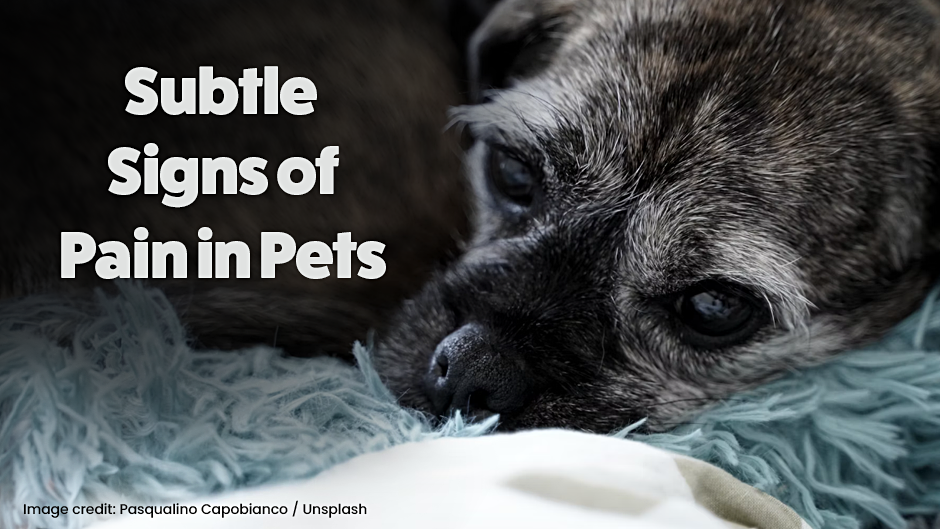
Subtle Signs of Pain in Pets
As a veterinary team, one of the most important conversations we have with pet parents is about pain. Unlike us, our pets can’t simply tell us when something hurts. They often mask their discomfort, making it difficult to recognize the early signs of pain. Whether your pet is growing older or experiencing an acute injury, understanding the subtle indicators of pain is one of the best things you can do as a pet owner to facilitate your pet’s overall wellbeing.
How to Identify Pain in Your Pet
Recognizing when your pet is in pain can be challenging. Many pets, especially cats and dogs, are experts at hiding their discomfort. However, there are some signs that may indicate your pet is experiencing pain:
- Changes in behavior: If your pet has become unusually quiet, withdrawn, or irritable, it could be due to discomfort.
- Decreased activity: A pet that no longer shows interest in walks or playtime may be in pain.
- Limping or stiffness: Difficulty getting up, limping, or stiff movements are common indicators of joint or muscle pain.
- Vocalization: Whining, whimpering, or other unusual vocalizations could suggest discomfort.
- Changes in appetite or sleep patterns: If your pet is eating less or seems restless at night, pain might be the culprit.
These signs can often be mistaken for aging, but growing older doesn’t mean your pet has to live in pain. If you notice any of these behaviors, talk to us about pain management options for your pet.
Discussing Pain Management with Your Veterinarian
There are numerous ways we can help manage your pet’s pain. Each pet is unique, and pain management can be tailored to their specific needs. Depending on your pet’s lifestyle, age and overall health, some of these options may include the following:
- Laser therapy: This non-invasive treatment helps reduce inflammation and promotes healing, making it a great option for pets with arthritis or chronic pain.
- Physical therapy and rehabilitation: Pets, like humans, benefit from rehabilitation exercises to strengthen muscles, improve mobility, and relieve pain.
- Supplements: There are many natural supplements available that can aid in joint support and reduce inflammation.
- Surgery: In some cases, surgery may be necessary to address the underlying cause of your pet’s pain, such as a torn ligament or spinal issues.
- Prescription medications: We can prescribe pain relievers that are safe and effective for pets, helping to control pain and improve their quality of life. It’s important to never give your pet human medication, unless it has been recommended by our team. Many human medications can have toxic effects in pets.
If you suspect your pet is in pain, don’t wait to have a conversation with us. We can work together to ensure they live a comfortable, happy life. After all, more than 45 million household pets suffer from chronic or acute pain , and early intervention can make all the difference in their health and happiness.
Your Pet Deserves a Pain-Free Life
No pet should have to endure pain, especially as they age. Pain management is about improving your pet’s quality of life and helping them enjoy their golden years. There are many options available, from therapies to medications, and the right solution will depend on your pet’s specific needs.
Let’s have a conversation about what we can do to make sure they’re as comfortable as possible. We’re here to help your pet live their best, pain-free life.

Why Your Cat Needs to See the Vet
When was the last time your cat visited the vet? Cats are known for their independent and often aloof nature, which can sometimes lead to the misconception that they don’t require regular veterinary care. However, just like dogs, cats need routine checkups to ensure they live long, healthy lives.
Common Misconceptions About Cat Health
A common belief among cat owners is that cats, especially indoor ones, are low-maintenance pets that don’t need to visit the vet as frequently as dogs. This is far from the truth. While cats might not always show obvious signs of discomfort or illness, they can suffer from a variety of health issues that, if left unchecked, could lead to more serious conditions. Regular vet visits are the key to catching these issues early.
Signs Your Cat Needs to Visit the Vet
Cats are masters at hiding pain, so it’s important to watch for subtle changes in behavior or physical condition. Some signs that your cat may need to see the vet include:
- Changes in eating or drinking habits
- Unexplained weight loss or gain
- Lethargy or decreased activity levels
- Issues with the litter box, such as straining, frequent urination, or not using it at all
- Unusual grooming behaviors, like excessive licking or not grooming themselves
If you notice any of these signs, it’s time to schedule a vet visit. These symptoms could indicate anything from dental disease to kidney issues—conditions that require a veterinarian’s expertise to diagnose and treat.
Preventive Care: The Key to a Longer, Healthier Life
Regular veterinary care isn’t just for when your cat is sick. Preventive care plays a vital role in keeping your cat healthy. During a routine checkup, your vet will perform a thorough physical examination, which can help detect early signs of common issues like dental disease, obesity, and chronic conditions like diabetes or hyperthyroidism.
Vaccinations, parasite prevention, and dental exams are essential services that your vet provides to keep your cat in peak health. Even if your cat seems perfectly healthy, these routine visits can prevent future problems and even save you money in the costs of more complex care.
Senior Cats Need Extra Attention
As cats age, their health care needs change. Senior cats (typically those over 7 years old) should visit the vet more frequently, at least twice a year. These visits often include screenings for age-related conditions such as arthritis, kidney disease, and hyperthyroidism. Early detection of these conditions can make a significant difference in managing your cat’s health as they age.
How Often Should Your Cat Visit the Vet?
Generally, it’s recommended that cats visit the vet at least once a year for a wellness exam. Kittens and senior cats may need more frequent visits, while adult cats typically benefit from an annual checkup. Your vet can give you specific guidance based on your cat’s health and lifestyle.
Even if your cat appears healthy, don’t skip these routine visits. They are essential for preventive care and catching any potential issues before they become more serious.
Getting Your Cat to the Vet: 3 Helpful Tips
We understand that getting your cat to the vet can be a challenge. Here are three tips to make the trip easier:
- Get Your Cat Accustomed to the Carrier: Leave the carrier out in a familiar place with a cozy blanket inside. Occasionally place treats or toys inside to create positive associations with the carrier.
- Schedule Vet Visits During Quieter Times: If possible, book your appointment during less busy hours. Fewer people and animals in the waiting room can reduce your cat’s stress.
- Use Pheromone Sprays or Calming Treats: Products like Feliway, a synthetic feline pheromone, can help reduce anxiety. You can spray it in the carrier or use calming treats before the visit to help your cat feel more at ease.
Your Cat Deserves the Best Care
Regular veterinary visits are an investment in your cat’s long-term health and happiness. Don’t wait until there’s a problem—give our clinic a call to schedule an appointment today. Your cat will thank you for it!
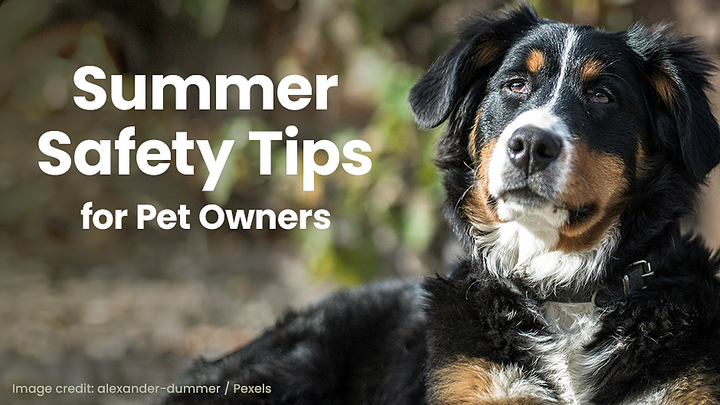
Summer Safety Tips for Pet Owners
Summer is a time for fun, relaxation, and outdoor activities. However, while we enjoy the warm weather, we need to take extra precautions to ensure our pets stay safe and healthy. Read on for valuable tips on keeping your pets safe during the summer months, addressing critical aspects such as hydration, anxiety from loud noises, increased activity levels, and encounters with wildlife.
Hydration: The Key to Summer Safety
One of the most important aspects of pet care during the summer is ensuring your pets stay hydrated. Dehydration can lead to severe health issues, and it’s particularly common during the hot summer months.
Signs of Dehydration
- Dry gums and nose
- Loss of skin elasticity
- Panting
- Lethargy
Hydration Tips
- Constant Supply of Fresh Water: Ensure your pets always have access to clean, fresh water. Consider placing multiple water bowls around your home and yard.
- Portable Water Bottles: If you’re taking your pet out for a walk or to the park, carry a portable water bottle designed for pets.
- Hydrating Treats: Offer hydrating treats such as ice cubes made from low-sodium broth or watermelon, which is safe for dogs in moderation.
- Avoid Excessive Exercise: Limit physical activity during the hottest parts of the day to prevent overheating and dehydration.
Managing Anxiety from Loud Noises
Summer often brings thunderstorms and fireworks, both of which can cause significant anxiety in pets. This anxiety can lead to destructive behavior, attempts to escape, and even physical health issues.
Identifying Anxiety Symptoms
- Trembling or shaking
- Hiding or seeking comfort
- Excessive barking or meowing
- Restlessness
Anxiety Relief Strategies
- Create a Safe Space: Designate a quiet, comfortable area in your home where your pet can retreat during loud events. This space should be filled with their favorite toys and bedding.
- Consider Calming Products: Products such as anxiety wraps, pheromone diffusers, or natural supplements can help reduce the stress your pets are experiencing.
- Behavioral Training: Gradual desensitization to loud noises through controlled exposure can help. Work with a professional trainer if needed.
- Consult With Us: In some cases, our veterinary team may prescribe anti-anxiety medication to help manage your pet’s stress.
Increased Activity and Social Gatherings
Summer barbecues and get-togethers mean more activity and potential hazards for pets. While it’s great to involve your pets in family fun, it’s important to keep their safety in mind.
Activity Safety Tips
- Supervise Playtime: Always keep an eye on your pets during gatherings to prevent them from eating harmful foods or getting into dangerous situations.
- Avoid Toxic Foods: Common barbecue foods like onions, garlic, chocolate, and alcohol are toxic to pets. Ensure these items are out of reach.
- Exercise Caution with Decorations: Party decorations, such as balloons and streamers, can be hazardous if ingested. Keep them away from curious pets.
- Practice Leash Safety: If your pet is not familiar with all the guests, keep them on a leash to prevent unexpected escapes or aggressive behavior. And, while we’re talking about unexpected escapes, now’s also a good time to make sure your pet’s microchip registration is up to date. No microchip? Schedule an appointment with us. Microchips give your pet the best chance of being reunited with you.
- When in Doubt, Give Your Pet a Safe Retreat: Some children simply are not aware of how to approach pets or play with them safely. This can cause stress for pets, and in worst case scenarios, lead to bites or other aggressive behavior. Give your pet a safe retreat where they can avoid the extra hustle and bustle.
Wildlife Encounters in Your Backyard
Summer also brings more wildlife into our yards, including raccoons, snakes, and other creatures. These animals can pose risks to your pets, so it’s essential to take measures to keep your backyard safe.
Wildlife Safety Tips
- Secure Trash Cans: Raccoons and other wildlife are attracted to food scraps. Use secure, animal-proof trash cans to keep them at bay.
- Remove Food Sources: Avoid leaving pet food outside, and clean up any fallen fruits from trees promptly.
- Inspect Your Yard: Regularly check your yard for signs of wildlife, such as burrows or nests, and take steps to deter them if found.
- Use Fencing: Install fencing around your yard to prevent larger wildlife from entering. Ensure that the fence is high enough and buried deep enough to prevent digging.
Conclusion
By following these summer safety tips, pet owners can ensure their furry friends remain healthy, happy, and safe throughout the season. From maintaining proper hydration and managing anxiety to supervising increased activity levels and safeguarding against wildlife, these measures will help keep your pets protected.
Stay informed, stay vigilant, and enjoy a wonderful summer with your beloved pets!
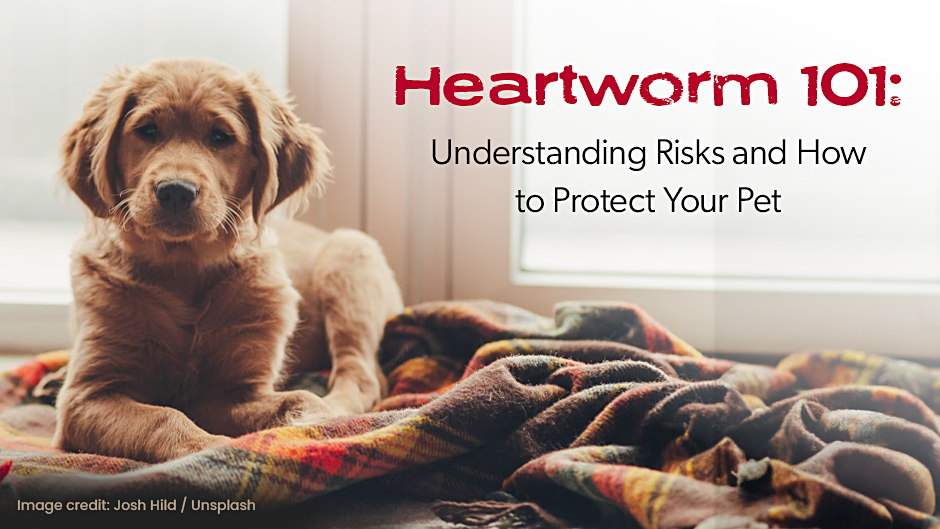
Heartworm 101: Understanding Risks and How to Protect Your Pet
Among the various health risks that pets face, heartworm disease stands out as a particularly insidious threat. This disease can have devastating effects on your pet, and yet, it is preventable. This article will delve into heartworm disease and stress the importance of proactive prevention.
Understanding Heartworm Disease
Heartworm disease is a serious and potentially life-threatening illness triggered by parasitic worms known as Dirofilaria immitis. These worms inhabit the heart, lungs, and connected blood vessels of afflicted pets. These parasites are transmitted through the bite of an infected mosquito, making the disease a concern for pet owners anywhere that mosquitos are present.
The progression of heartworm disease is slow but relentless. Infected pets may not show symptoms until the disease has advanced significantly, making early detection challenging. Symptoms include the following:
- Mild persistent cough
- Reluctance to exercise
- Fatigue after moderate activity
- Decreased appetite
- Weight loss
If left untreated, heartworm disease can lead to severe lung disease, heart failure, and other organ damage, ultimately proving fatal.
The Transmission Cycle Explained
The lifecycle of the heartworm begins when a mosquito feeds on an infected animal, ingesting microfilariae (baby worms) in the process. Within the mosquito, these microfilariae develop into infective larvae. When this infected mosquito then bites a healthy pet, the larvae are transmitted into the new host, where they mature into adult heartworms over a period of 6 months.
Understanding this transmission cycle underscores the importance of year-round preventive measures to protect your beloved pets from the grip of heartworm disease.
Prevention Over Treatment
Protection against heartworms is not just preferable—it’s essential. The treatment for heartworm disease is both costly and challenging, involving a long and potentially risky process to eliminate the adult worms from your pet’s body. Furthermore, the damage inflicted by the disease may have lasting effects on your pet’s health.
On the other hand, heartworm prevention is safe, effective, and far more economical. Preventive measures include monthly oral or topical medications, and in some cases, injectable products that can provide protection for extended periods. By incorporating heartworm prevention into your pet’s routine care, you’re not just safeguarding them against heartworms but also ensuring their overall health and longevity.
Trust Us With the Health of Your Pet
We understand the unique health history and needs of your pet. Our team is here to provide personalized recommendations on the most appropriate heartworm prevention protocol tailored to your pet’s unique risk factors and lifestyle. By purchasing heartworm prevention products directly from us, you can be assured of their authenticity, efficacy, and suitability for your pet.
Preventive care is the cornerstone of maintaining your pet’s health and well-being across all life stages. Don’t wait for heartworm disease to become a problem—proactive prevention is the key.
Call us to request an appointment today. Our dedicated team is ready to assist you in fortifying your pet’s defenses against heartworm disease, educating you on the best practices for preventive care, and supporting you every step of the way in your pet’s health journey. Together, we can ensure your pet leads a happy, healthy, and heartworm-free life.

Household Hazards: Understanding and Mitigating Pet Poisoning Risks
Owning a pet offers immeasurable joy, companionship, and love. However, it also comes with the responsibility of ensuring their safety and well-being. Many common items found in our homes could pose significant poisoning risks to our furry companions. By understanding these hazards and how to prevent them, we can create a safer environment for our pets.
Key Household Hazards for Pets
Chocolate
Widely known but often underestimated, chocolate contains theobromine, which is toxic to dogs and cats. Even small amounts can cause vomiting, diarrhea, and more severe symptoms. As you’re filling Easter baskets or baking holiday treats, be mindful to keep chocolate out of reach and clean up any spills immediately.
Houseplants
Many popular houseplants are poisonous to pets. For instance, lilies can cause kidney failure in cats, and sago palms can be lethal if ingested by pets. This time of year, in particular, brings an abundance of lilies, tulips, and daffodils, so be extra cautious.
Medications
While medications are meant to help us, they can be dangerous for pets. Keep all prescriptions and over-the-counter drugs securely locked away from curious paws if you’re entertaining guests for holiday festivities, store handbags, coats, and other items that may contain toxins out of reach, as well. Never give your pet any medication without consulting a veterinarian first.
Cleaning Products
Household cleaners, such as bleach, disinfectants, and laundry pods, can cause severe chemical burns and respiratory issues in pets if ingested or inhaled. Always place these items out of reach of pets, and thoroughly rinse any surfaces where they’ve been used.
Trash and Unattended Items
The trash can is a treasure trove of potential dangers—from coffee grounds to spoiled leftovers to food packaging. Keep it securely closed and don’t leave any items unattended, as pets may be tempted to chew or ingest them.
Practical Prevention Tips
View Your Home Through Your Pet’s Eyes
Get down to their level and identify potential risks—place chocolate in unreachable places, ensure houseplants are out of reach, and keep medications locked away.
Secure Trash and Unattended Items
Ensure trash is inaccessible and routinely check bags, backpacks, and purses for any items that could harm your pet. Make a routine of placing these items out of reach when you come home.
Recognizing Symptoms of Pet Poisoning
Be vigilant for signs of distress in your pets, such as vomiting, diarrhea, lethargy, and excessive drooling. Early recognition can make a significant difference in outcomes.
Emergency Actions for Pet Owners
In the unfortunate event that you suspect your pet has ingested a poisonous substance, prompt action is critical. Immediately call your veterinarian or a pet poison control center. Time is of the essence, and their guidance could save your pet’s life.
Maintaining a pet-friendly environment requires diligence and an ongoing commitment to their safety. By proactively identifying hazards and implementing preventive measures, we can vastly reduce the risk of pet poisoning. Remember, our pets rely on us for their well-being—it’s our duty to protect them.
For further information on pet care and emergency resources, please do not hesitate to reach out to us.
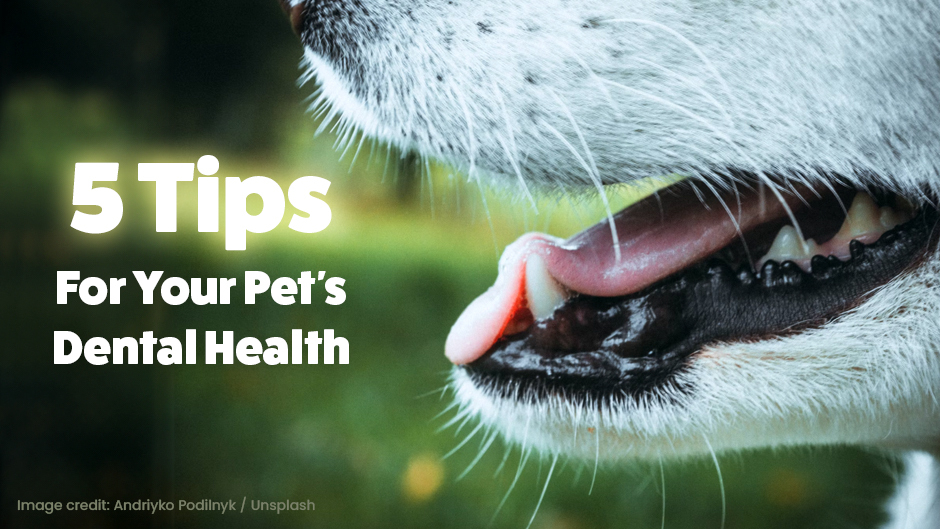
5 Tips for Your Pet’s Dental Health
We all wish for our furry friends to live happy, healthy lives by our side. But often overlooked in pet care is a critical area that affects their overall well-being: dental health. Just like us, pets’ teeth need regular attention to prevent discomfort, disease, and systemic health issues. In this article, we’ll provide you with five essential tips to give your pet the sparkling, healthy smile they deserve!
The Benefits of a Healthy Smile
The twinkle in your pet’s eye is often matched by the joy in their smile. But beneath the surface, dental issues in pets can lead to pain, infection, and even heart or kidney problems. Being proactive with dental health can add years of wiggly, wet-nosed companionship to your pet’s life.
Tip 1: Regular Brushing
Dental brushing is the gold standard for pet oral health. With a little patience and the right method, you can make it an enjoyable part of your pet’s routine.
- Technique: Start slow with just a finger to get them used to the sensation. Gradually introduce a pet toothbrush and toothpaste formulated for pets. Never use human toothpaste to brush your pet’s teeth.
- Frequency: Aim for a daily brushing session. Consistency is key to keeping teeth and gums in top condition.
- Tools: Soft-bristled brushes and enzymatic toothpaste made for pets are gentle options designed for delicate pet mouths.
Tip 2: Appropriate Dental Diet
What your pet eats significantly impacts their dental health. Choose their meals wisely to support strong teeth and gums.
- Dry Kibble: The crunch of kibble can be a good mild abrasive, helping to clean teeth as your pet chews.
- Special Formulas: Some pet foods are engineered with dental health in mind, designed to decrease plaque and tartar buildup. We can help provide suggestions which take into consideration your pet’s age, lifestyle and overall health needs.
Tip 3: Chew Toys and Dental Treats
Chew toys and specially designed treats can be your pet’s best buddies in the battle against plaque.
- Chew Toys: Tough rubber, nylon, or rawhide chews can provide a satisfying and tooth-scraping experience for your pet.
- Treats: Dental treats can be a tasty, effective way to reduce plaque and tartar.
Ask us about the safest options for chews and treats that will provide benefits to your pet’s dental health.
Tip 4: Professional Dental Cleanings
Despite your best efforts, some dental issues require professional intervention.
- Importance: Regular visits to a veterinary dentist ensure that both routine cleaning and potential issues are addressed promptly.
- Frequency: Your vet is the best person to advise on how often your pet needs professional dental care. Typically we recommend professional dental cleanings one time per year.
- Anesthesia: While it can be a concern, modern techniques have made it very safe for sedating your pet for thorough dental cleaning. This allows us to identify dental disease below the gumline and develop a comprehensive treatment plan specific to your pet.
Tip 5: Monitoring Oral Health
Knowing the signs of dental issues can help you catch and treat problems early.
- Visual Checks: Regularly inspect your pet’s teeth and gums. Look for signs of bleeding, bad breath, or swelling.
- Behavioral Clues: Changes in eating habits or excessive drooling can signal dental discomfort, prompting a closer examination.
- Regular Veterinary Visits: Your vet visit isn’t complete without a quick oral examination. Don’t hesitate to raise any dental concerns you might have, and reach out to us to schedule an appointment.
Your Pet’s Smile is Your Mission
Your pet’s dental care is a partnership between you and your trusted veterinarian. Implementing these key tips will not only enhance your pet’s quality of life but also save you from potential veterinary expenses in the future. Remember, their well-being is in your hands, from choosing the right dental diet to detecting early signs of trouble. So, scoop up that toothbrush and let’s give your pet the megawatt smile they were born to flaunt!
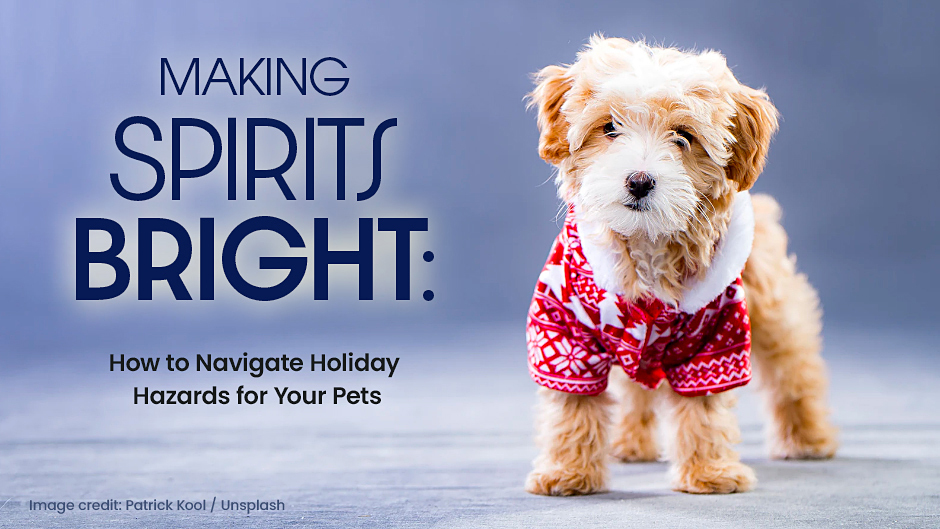
Making Spirits Bright: How to Navigate Holiday Hazards for Your Pets
The holiday season is a time of joy and celebration, but it can also bring unexpected challenges for pet owners. As a veterinary team, we’ve seen our fair share of holiday-related pet emergencies, from tinsel ingestion to Christmas tree accidents. But with a little bit of preparation and foresight, you can help keep your pet friends safe and healthy this holiday season. In this blog, we’ll share some common holiday hazards for pets and offer practical tips for avoiding them.
Deck the Halls with Care: Managing Your Holiday Decorations
The dazzling lights, sparkling tinsel, and shiny ornaments that fill our homes during the holidays can be as captivating for our pets as they are for us. But some holiday decorations can also pose serious health risks to our furry friends. For example, tinsel, garland, and ribbon can easily cause intestinal blockages if ingested by pets. Likewise, breakable ornaments can cause cuts to your pet’s mouth or paws, and chewed electrical cords can cause burns or even electrocution.
To keep your pets safe during the holidays, make sure to secure all decorations, such as tinsel, garland, and ribbon, to prevent your pet from ingesting them. If you have a curious pet that likes to play with decorations, consider using safer decorations such as felt or paper products.
Oh, Christmas Tree: Managing Your Tree and Lights
Setting up the Christmas tree is a beloved tradition in many homes, but it also requires vigilance when it comes to pet safety. Pine needles, if ingested, can cause stomach issues for pets, and the water that keeps the tree fresh can also be toxic to your pet. Additionally, broken ornaments or lights can pose an electrical and choking hazard to pets.
To prevent these hazards, make sure to sweep up any pine needles that drop from your tree regularly. Also, consider covering the tree stand with a skirt or some other barrier to keep your pets away from the water. Finally, place ornaments higher up on the tree, and consider using shatterproof ornaments to help reduce the risk of accidental breakage.
If necessary, you may even want to block off the tree from pet access.
The Gift of Health: Protecting Your Pets from Parasites
In the hustle and bustle of the holiday season, it can be easy to forget important preventative care for your pets, such as parasite protection. Fleas, ticks, heartworms, and intestinal parasites don’t take a holiday, and can make your pet miserable if not properly treated or prevented.
To keep your pet healthy, make sure to provide them with monthly parasite prevention according to your veterinarian’s recommendations. This can include oral or topical medications for flea and tick control and heartworm preventatives. By staying on top of parasite prevention, you can help ensure your pet stays happy and healthy all year long.
Share the Love: Spending Quality Time with Your Pet During the Holidays
Finally, one of the best ways to keep your pet safe and happy during the holidays is by spending quality time with them. Pets thrive on attention and companionship, and the holidays can be a perfect opportunity to show your pet how much you care. From going on walks to cuddling up on the couch for a movie marathon, there are plenty of ways to share the holiday spirit with your furry friend.
The holidays can be a joyful time for pets and their owners, but they can also pose unexpected hazards if not properly managed. By taking precautions such as securing decorations, managing your Christmas tree, staying on top of parasite prevention, and spending quality time with your pet, you can help ensure a safe and happy holiday season for everyone in your household. We wish you and your pets a joyous and safe holiday season!
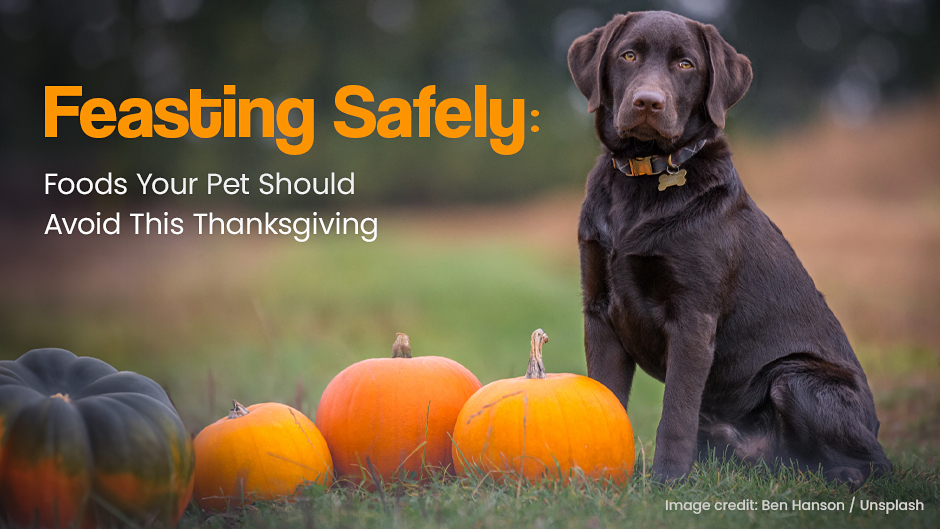
Feasting Safely: Foods Your Pet Should Avoid This Thanksgiving
As Thanksgiving approaches, we all prepare to indulge in festive treats and a hearty Thanksgiving meal. But as pet owners, we must remember that our furry friends should not indulge in the same way. This Thanksgiving, we have compiled a list of foods your pet should avoid. Read on to learn how to keep your pets safe while you enjoy a delicious feast.
Onions and Garlic
Onions and garlic, whether they are cooked or raw, are toxic to pets. Make sure to keep onions and garlic out of reach of your pets, and never feed food to pets that may contain these ingredients, such as stuffing or other side dishes. Symptoms of ingestion include abdominal pain, vomiting, diarrhea, and lethargy. If you suspect your pet has consumed any food containing onions or garlic, seek veterinary care immediately.
Grapes and Raisins
Grapes and raisins are common in Thanksgiving dishes, such as stuffing or salads. However, consumption can lead to kidney failure, which can be fatal. Even small amounts of grapes or raisins can cause significant harm to your pet’s well-being. If your pet eats these items or foods containing them, seek veterinary care immediately.
Alcohol
Alcohol is present in many Thanksgiving drinks, such as beer, wine, and cocktails. However, pets should never consume alcohol, as they cannot metabolize it as humans do. Consumption can lead to vomiting, diarrhea, difficulty breathing, and even coma or death in severe cases. Keep all alcoholic beverages out of reach of your pets, and ensure that your guests do the same.
Turkey Bones & Gravy
While turkey is a staple in most Thanksgiving meals, pet owners should be careful about what part of the turkey their pets consume. Turkey bones are a hazardous choking and intestinal obstruction hazard for pets. Turkey skin and gravy are high in fat content and can lead to gastrointestinal upset such as vomiting and diarrhea. Keep your pets away from the kitchen and food if possible, and always dispose of turkey bones safely away from your pets.
Hidden Hazard – Medications
With extra people visiting your house for Thanksgiving, be aware that curious pets may discover medications in handbags or coat pockets. Commonly used over-the-counter painkillers can have disastrous consequences for your furry friends. If you are hosting guests this holiday, be sure to remind them to keep all medications secured and avoid leaving bags or pockets accessible to your pets. Better yet, consider putting your pet into a quiet room away from the commotion and potential food hazards.
This Thanksgiving, ensure that your pets are not harmed by any food or drink that may cross their path. By being mindful and keeping these forbidden foods in mind, your pets will remain safe and happy throughout the festive season. If you notice any symptoms of ingestion or injury to your pets, seek veterinary care immediately. Remember, extra caution goes a long way in creating a happy and healthy holiday season. We hope you and your beloved pets have a wonderful Thanksgiving holiday!
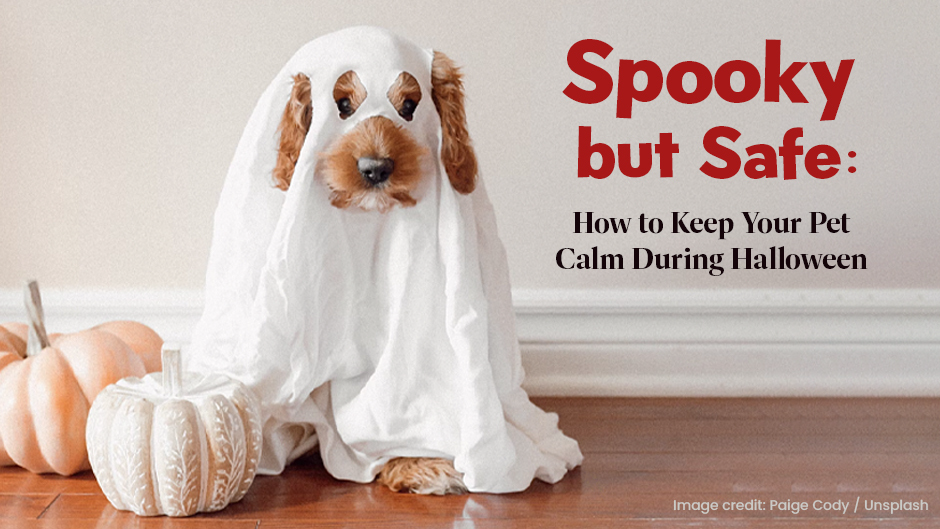
Spooky but Safe: How to Keep Your Pet Calm During Halloween
Halloween is one of the most awaited events for kids and adults. The streets are filled with people wearing creative costumes, decorations are everywhere you look, and sweet treats and the scent of pumpkin spice fill the air. While it is a festive occasion, this can also be a time of stress and anxiety for our pets. Here are some tips on how to keep your pet calm during Halloween:
Halloween is fun for people but can be stressful for pets
Halloween is a time to celebrate with friends and family and have fun with spooky costumes, which is why most people look forward to this holiday. However, for pets, it can be a terrifying experience. Often, they get scared by the sudden appearance of strangers, loud noises, and unfamiliar smells, which can lead to anxiety or even aggression. It’s essential to keep a close eye on your pet when the festivities are happening outside, and even inside your home.
Costumes can be scary and uncomfortable for pets
While dressing up in costumes can be fun, your pets might not be on board with the idea. Most pets are not used to wearing costumes, and the sensory experience can be overwhelming for them. Noisy, and tight clothes can make them uncomfortable, anxious, or even frightened. Moreover, costumes that involve masks or hats can limit their vision and hearing, further adding to their fear.
Beyond costumes⸺other dangers for pets
While costumes are a significant part of Halloween, there are other dangers you need to be aware of when it comes to your pets. Here are some of the most significant threats you need to watch out for:
- Candy/Chocolate: Halloween treats are not safe for pets. Chocolate, especially dark chocolate, can be toxic to dogs. Candy may contain xylitol, which is toxic to dogs and can cause severe consequences such as seizures, vomiting, and even death.
- Candles: Candles and pumpkins make for excellent Halloween decorations, but they can be hazardous to your pets. Your pet may accidentally knock over the candle which could lead to injury or in the worst-case scenario, a fire.
- Excitement at the door: Trick-or-treaters knocking at the door can be a happy moment for people, but it might cause stress for your pets. The constant knocking, ringing, or noise can induce fear or anxiety in pets.
- Extra Noise: The loud noises from doorbells or people laughing and cheering outside the door can also be frightening for pets. These things may also cause behavioral issues like anxiety, fear, or stress in our pets.
How to create a quiet space for your pet
It’s essential to create a comfortable and safe space for your pet during Halloween. You can create a little corner for them in your home, with their bed, toys, and blanket. It should be a quiet room away from the front entrance. Also, consider adding white noise or calming music to soothe their nerves.
Halloween can be stressful for pets, and it’s essential to take action to ensure their safety. Be aware of the potential dangers that could harm your furry friend and take steps to keep them out of harm’s way. Creating a quiet space for them and avoiding costumes will make a significant difference in their stress levels. With these tips, you will have a safe and happy Halloween with your furry loved one.
